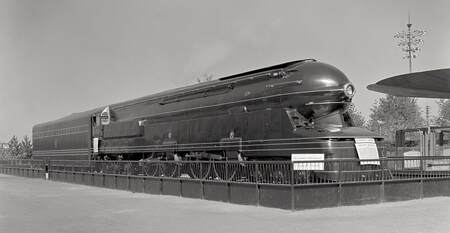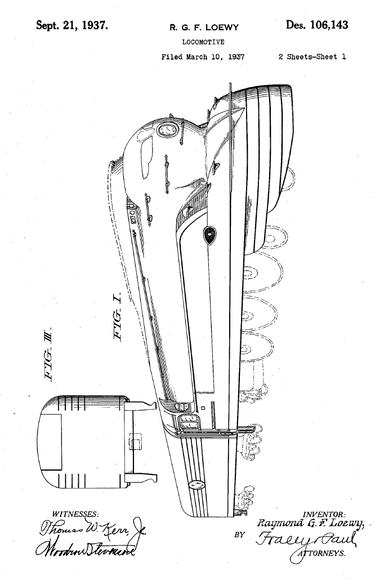 The S1 at the New York World's Fair
The S1 at the New York World's Fair
On September 21, 1937, U.S. Design Patent No.: 106,143 issued to Raymond G.F. Loewy for the design for the S1 steam locomotive of the Pennsylvania Railroad Company (PRC). At 140 feet, 2 1/2 inches and 97,600 pounds, the S1 was the longest and heaviest rigid frame reciprocating steam locomotive that was ever built and was aptly nicknamed "The Big Engine". The S1 had a unique construction, with a 6-4-4-6 wheel arrangement, meaning it had six leading wheels, two sets of four driving wheels and six trailing wheels. The four driving wheels were driven by two pairs of cylinders, which classified the S1 as a duplex locomotive.
Raymond Loewy was hired by PRC to design the exterior of the S1. Loewy was a well-known industrial designer, who had been born in France and became a U.S. citizen in 1939. Loewy designed the exterior of the S1 to have a streamlined Art Deco look. In addition to being protected by the '143 design patent, the exterior of the S1 was also protected by U.S. Patent No.: 2,128,490, which was a utility patent that issued to Loewy on July 17, 1936 and was assigned to PRC.
Construction of the S1 was completed on January 31, 1939, but the S1 did not immediately go into service. Instead, the S1 was displayed at the New York World's Fair, which opened in April of 1939 and closed in October 1940. After the fair, the S1 went into service in December, 1940. However, due to its large size and unique construction, the S1 was limited to service on PRC's main line between Chicago, Illinois and Crestline, Ohio. Although Crestline was a small town, it housed major engine facilities for PCR and was the location where engines were often swapped for the relatively flat runs to and from Chicago.
Although its great size limited its usefulness, the S1 was a powerful locomotive that could travel at great speed. Although unverified, speeds in excess of 140 mph have been attributed to the S1. In fact, one story relates how the S1 was fined for traveling 156 mph on the Fort Wayne-Chicago Railroad. However, no records exist to lend credence to the story.
The S1 remained in service until at least May of 1946. Although preservation was briefly contemplated, the S1 was scrapped in 1949.
Raymond Loewy was hired by PRC to design the exterior of the S1. Loewy was a well-known industrial designer, who had been born in France and became a U.S. citizen in 1939. Loewy designed the exterior of the S1 to have a streamlined Art Deco look. In addition to being protected by the '143 design patent, the exterior of the S1 was also protected by U.S. Patent No.: 2,128,490, which was a utility patent that issued to Loewy on July 17, 1936 and was assigned to PRC.
Construction of the S1 was completed on January 31, 1939, but the S1 did not immediately go into service. Instead, the S1 was displayed at the New York World's Fair, which opened in April of 1939 and closed in October 1940. After the fair, the S1 went into service in December, 1940. However, due to its large size and unique construction, the S1 was limited to service on PRC's main line between Chicago, Illinois and Crestline, Ohio. Although Crestline was a small town, it housed major engine facilities for PCR and was the location where engines were often swapped for the relatively flat runs to and from Chicago.
Although its great size limited its usefulness, the S1 was a powerful locomotive that could travel at great speed. Although unverified, speeds in excess of 140 mph have been attributed to the S1. In fact, one story relates how the S1 was fined for traveling 156 mph on the Fort Wayne-Chicago Railroad. However, no records exist to lend credence to the story.
The S1 remained in service until at least May of 1946. Although preservation was briefly contemplated, the S1 was scrapped in 1949.


